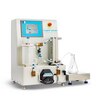A protein complex containing the conserved Swi2/Snf2-related ATPase Swr1p deposits histone variant H2A.Z into euchromatin.
Kobor, MS; Venkatasubrahmanyam, S; Meneghini, MD; Gin, JW; Jennings, JL; Link, AJ; Madhani, HD; Rine, J
PLoS biology
2
E131
2004
Mostrar resumen
The conserved histone variant H2A.Z functions in euchromatin to antagonize the spread of heterochromatin. The mechanism by which histone H2A is replaced by H2A.Z in the nucleosome is unknown. We identified a complex containing 13 different polypeptides associated with a soluble pool of H2A.Z in Saccharomyces cerevisiae. This complex was designated SWR1-Com in reference to the Swr1p subunit, a Swi2/Snf2-paralog. Swr1p and six other subunits were found only in SWR1-Com, whereas six other subunits were also found in the NuA4 histone acetyltransferase and/or the Ino80 chromatin remodeling complex. H2A.Z and SWR1 were essential for viability of cells lacking the EAF1 component of NuA4, pointing to a close functional connection between these two complexes. Strikingly, chromatin immunoprecipitation analysis of cells lacking Swr1p, the presumed ATPase of the complex, revealed a profound defect in the deposition of H2A.Z at euchromatic regions that flank the silent mating type cassette HMR and at 12 other chromosomal sites tested. Consistent with a specialized role for Swr1p in H2A.Z deposition, the majority of the genome-wide transcriptional defects seen in swr1Delta cells were also found in htz1Delta cells. These studies revealed a novel role for a member of the ATP-dependent chromatin remodeling enzyme family in determining the region-specific histone subunit composition of chromatin in vivo and controlling the epigenetic state of chromatin. Metazoan orthologs of Swr1p (Drosophila Domino; human SRCAP and p400) may have analogous functions. Artículo Texto completo | Western Blotting | 15045029
 |















